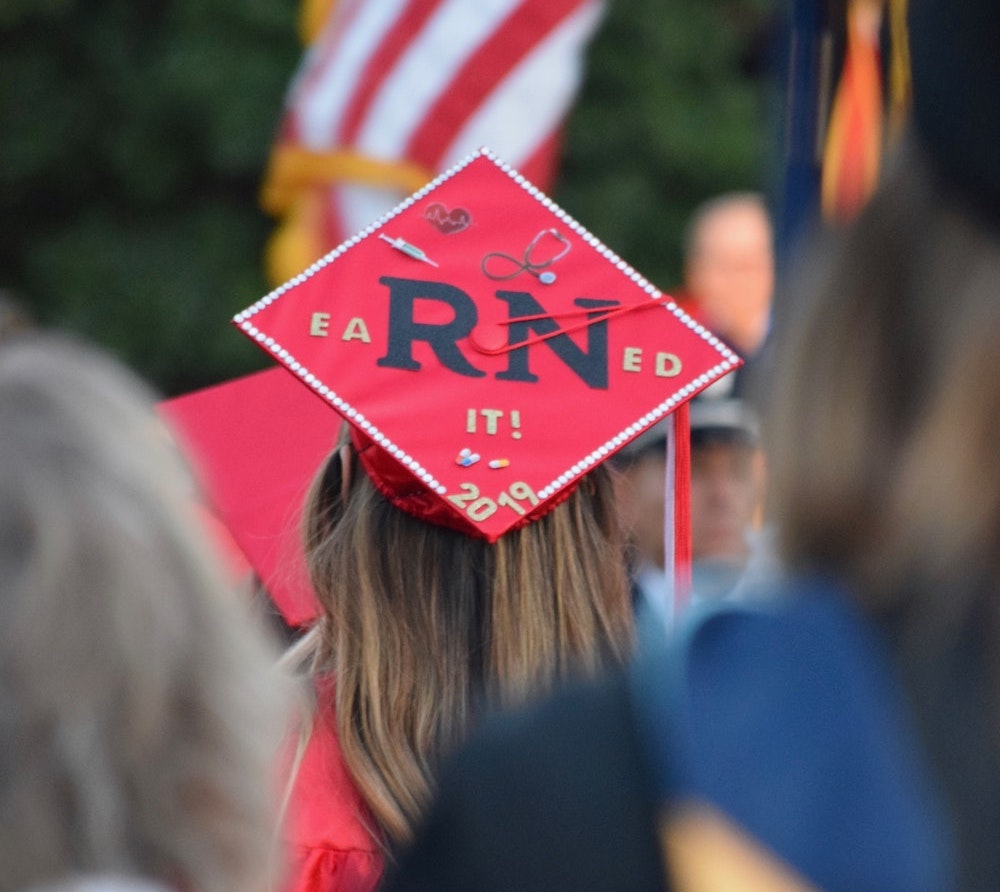This report explores the state of pre-licensing nursing education in Connecticut. It focuses on Registered Nursing (RN) and Licensed Practical Nursing (LPN) programs.
This is an old survey analysis. See the most recent analysis.
The survey data is for the period of 1 January 2019 to 31 December 2019. It was collected and analyzed in early 2020, published in August 2020, and amended in July 2021 to correct student demographics. See 2017 survey data analysis here.
Programs
Registered Nurses Degree Programs
In 2019, there were twenty-eight (28) accredited RN Pre-licensure program options in Connecticut. Of those,
- Ten (10) are 4-year baccalaureate programs (including new programs at the University of Hartford and University of Bridgeport),
- Nine (9) are 12–15 months accelerated or 2nd degree programs,
- Eight (8) are 2-year associate degree programs,
- and one (1) is a master's entry program at Yale School of Nursing.
Statewide, the RN programs seat capacity was 2,713 students. With 10,811 qualified applicants and 6,004 (55.5%) admitted and 232 (2.1%) waitlisted, the first-day enrollment stood at 2,658 (98% of capacity). Among the enrolled students, 107 (4%) were holding an LPN license.
Due to near capacity enrollments and limited attrition in state's RN programs, the only way that the State of Connecticut can increase annual graduation numbers for the RN would be to expand enrollments at the existing schools.
How does it compare to 2017 survey results?
In 2017, Connecticut had 2,452 seats for RN program applicants. 2,368 students enrolled on day one of class. Of those enrolled, 80 (3.4%) students disclosed that they held an LPN license.
2019 Enrollment
In 2019, the total of 7,226 students were enrolled in RN education programs across Connecticut. Of these students enrolled,
- 2,651 (36.7%) are in an associate degree program,
- 4,018 (55.5%) are in a baccalaureate degree program,
- 449 (6.2%) are in an accelerated (or 2nd degree) program, and
- 108 (1.5%) are in a master's entry degree program.
- 992 (37%) are in an associate degree program,
- 1,207 (45%) are in a baccalaureate degree program,
- 354 (13%) are in an accelerated (or 2nd degree) program, and
- 108 (4%) are in a master's entry degree program.
RN Programs at the Associate Degree Level
Community Colleges
Six community colleges offer an RN program (associate degree). These are Capital, Gateway, Naugatuck Valley, Northwestern CT, Norwalk, and Three Rivers community colleges with combined new student capacity of 604 in 2019.
In 2019, they admitted 727 of 1,242 qualified applicants. Of those admitted, 596 enrolled, filling 99% of all available community college seats for RN programs.
Private Colleges and Universities
The two other associate degree programs are located at Goodwin University (formerly Goodwin College, seat capacity of 192 students in 2019) and St. Vincent's College at Sacred Heart University (seat capacity of 165).
The two programs had 1,238 qualified applicants in 2019, of which 543 were admitted (44%), and 396 enrolled, filling 111% of combined seat capacity of 357 students.
RN Programs at the Baccalaureate Level
Four (4) state universities offer an RN program (baccalaureate degree):
- Central Connecticut State University (seat capacity of 70, 67 enrolled),
- Southern Connecticut State University (80 seats, 78 enrolled),
- University of Connecticut (125 seats, 129 enrolled),
- Western Connecticut State University (90 seats, 90 enrolled).
Six (6) private universities offer an RN program (baccalaureate degree):
- Quinnipiac University (seat capacity of 160, 138 enrolled),
- Sacred Heart University (280 seats, 289 enrolled),
- University of Saint Joseph (92 seats, 69 enrolled),
- Fairfield University (175 seats, 157 enrolled),
- University of Hartford (100 seats, 100 enrolled),
- University of Bridgeport (90 seats, 90 enrolled).
Accelerated and 2nd Degree RN programs
There are nine (9) RN second degree programs, of which four are offered by the University of Connecticut.
- Quinnipiac University (seat capacity of 60 students, 63 enrolled in 2019),
- Southern Connecticut State University (36 seats, 36 enrolled),
- University of Saint Joseph (38 seats, 33 enrolled),
- Fairfield University (60 seats, 54 enrolled),
- Goodwin University (formerly Goodwin College, 24 seats, 24 enrolled),
- UConn CEIN – Groton (39 seats, 33 enrolled),
- UConn CEIN – Stamford (33 seats, 27 enrolled),
- UConn CEIN – Storrs (50 seats, 44 enrolled),
- UConn CEIN – Waterbury (46 seats, 40 enrolled).
RN Program at Master's Level
Yale University School of Nursing is the only institution in the state to offer a master's level RN program. In 2019, its new student seat capacity was 104. Of 220 qualified applicants, 167 were admitted, and 108 enrolled.
 Photo by Jane Carmona on Unsplash
Photo by Jane Carmona on Unsplash
Registered Nurse 2019 Graduates
A total of 1,954 RN students graduated in 2019, a 12.6% increase compared to 1,736 RN graduates according to 2017 survey results. The majority of RN students graduated with an associate degree (793 in 2019) and a bachelor's degree (662 in 2019).
Licensed Practical Nurse Programs
Lincoln Technical Institute, Porter & Chester, and Stone Academy are the three organizations in Connecticut that provide LPN training. They operate day and evening programs across 10 towns.
According to the 2019 survey, they had a combined capacity of 2,398 seats. 2,657 qualified applicants applied and 2,419 (91%) got admitted, and of those admitted 1,519 enrolled. As a result, 37% of LPN program seats remained unfilled.
How does it compare to 2017 survey results?
In 2017, there were 1,489 budgeted seats for LPN program applicants in Connecticut. 1595 qualified applicants applied to LPN programs, the vast majority of whom (98%) got admitted. 1183 students were enrolled on day 1 of class (21% of seats were not filled). 10% of students were male, and 90% were female.
Students
 Photo by National Cancer Institute on Unsplash
Photo by National Cancer Institute on Unsplash
Students by Age
Registered Nurses
About 68% of RN students are aged 17–25, and 83% are under the age of 31.
Licensed Practical Nurses
LPN students tend to be older than RN students. There are more LPN students aged 31 and over (1,574, or 51% of total) than there are those aged 17–30 (1,543, or 49% of total).
Students by Race
Below is the breakdown of RN and LPN students by race and Hispanic ethnicity. Other category includes American Indian/Alaska Native, Native Hawaiian/Pacific Islander students, as well as those self-identifying as having two or more races, and non-US citizens.
Registered Nurses
Two-thirds of students training to become registered nurses self-identified as white, about 11% as Hispanic or Latino, and 10% as Black or African American.
Licensed Practical Nurses
The majority of LPN students were Black African American (50%), followed by white non-Hispanic (19%). About 18% self-identified as Hispanic or Latino (18%).
Faculty & RN Administrative Staff
Most RN and LPN programs faculty have part-time positions, but most RN administrative staff members are full-time.
- Of 965 RN faculty positions, 32% are full-time and 68% are part-time.
- Of 102 RN administrative staff positions, 85% are full-time and 15% are part-time.
- Of 374 LPN faculty positions, 21% are full-time and 79% are part-time.
Faculty's Educational Attainment
Below is the breakdown of RN faculty and administrative staff, and LPN faculty members, both full- and part-time, by educational attainment.
Full-Time Faculty
The majority (59%) of full-time RN faculty have a doctoral degree or equivalent (a PhD, DNP, MD, Juris), and about 40% hold a master's degree. Most full-time LPN faculty hold a master's degree (64%), followed by a bachelor's degree (31%).
Part-Time Faculty
Most part-time RN faculty have a master’s degree (87%). The majority of part-time LPN faculty is split between those with a master's degree (50%) and a bachelor's degree (44%).
Faculty & Staff by Age
RN Faculty
The median age of RN faculty is about 50. In other words, half of all RN faculty is under the age of 50, and the other half is over. Among full-time RN faculty, however, nearly 2 in 3 are 51 and older.
RN Admin Staff
42% of RN admin staff are 30 and younger. Full-time RN admin staff tends to be younger, with 49% aged 40 and below. Of 16 part-time staff, 5 are aged 66-70.
LPN Faculty
LPN faculty are generally younger than RN faculty. 57% of all LPN faculty are under the age of 51. The same holds for part-time (57%), and full-time (54%) LPN faculty.
Faculty by Gender
The vast majority of RN and LPN faculty, both full- and part-time, are females. Only between 6-7% of all faculty and staff members are males.
Faculty & Staff by Race
The charts below show race and Hispanic ethnicity breakdown of full- and part-time RN and LPN faculty, and RN administrative staff. Generally, LPN faculty is more diverse than RN faculty. The proportion of white faculty members is higher among those working full-time.
Other category includes Native Americans, Native Hawaiian, and faculty
members who identify as 2 or more races. No Data category includes non-US citizens
and faculty who chose not to disclose their race.
Hover over bar charts to see both counts and percentages.